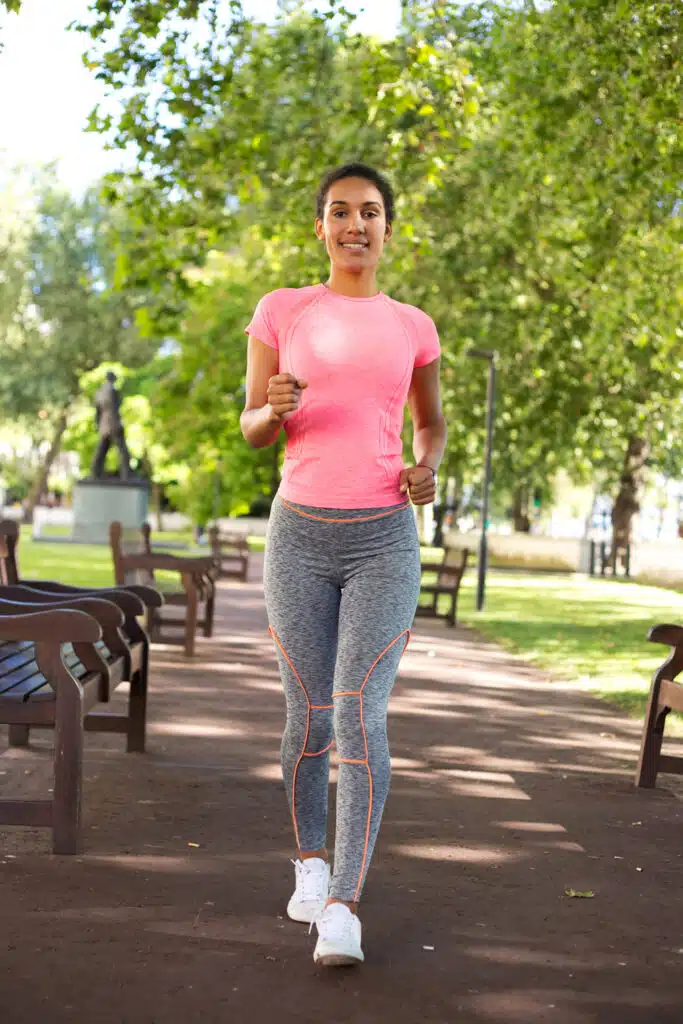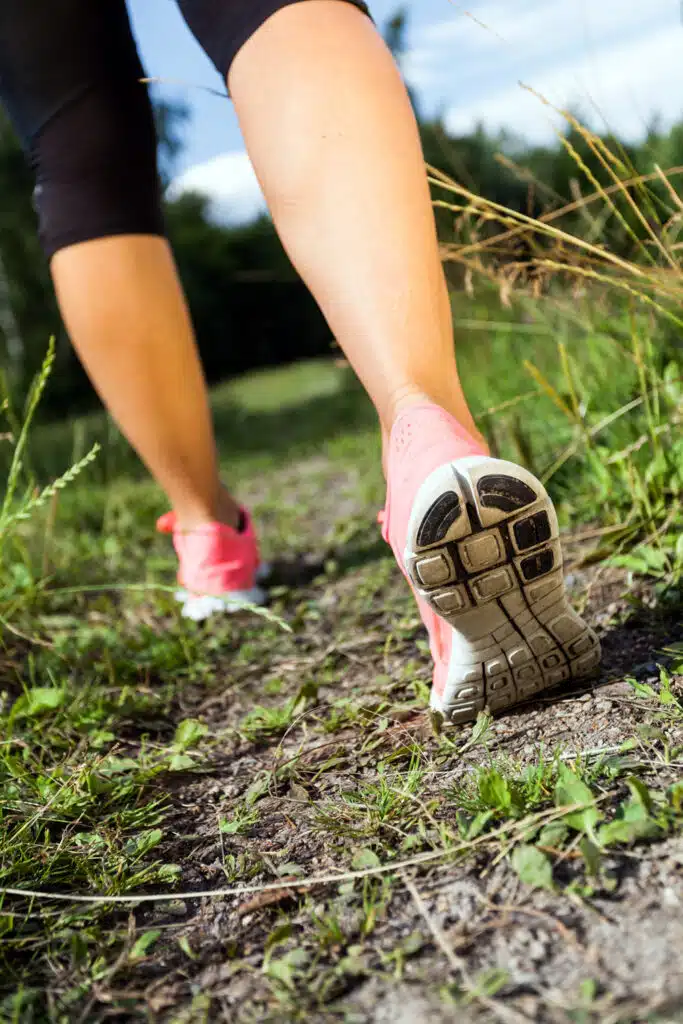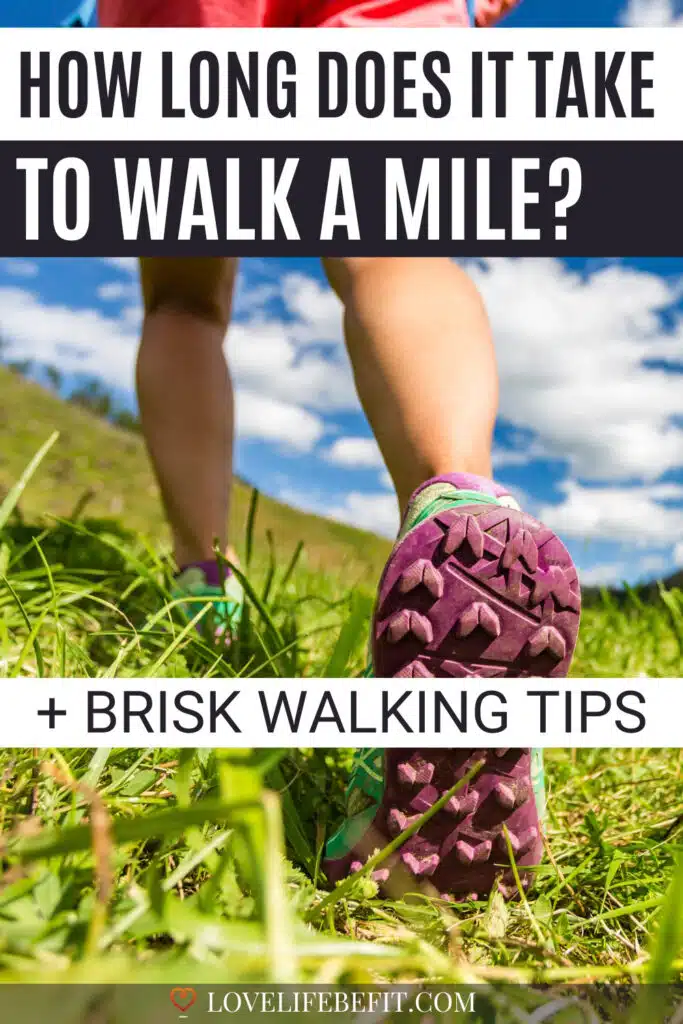Walking embraces everything from going for a stroll to walking for fitness or taking on a 5-mile hike. But how long does it take to walk a mile?
If you’re starting a walking program to improve your health and fitness, it’s good to know your average mile time. It’s a good indication of your fitness level and your physical health. After all, studies show fast walkers live longer!

How Far Is A Mile?
In case you prefer the metric system, a mile is 1.609 kilometers.
That’s just 9 meters more than 4 laps around a standard 400m athletics track.
Race walking is an Olympic event but the mile distance on the track is rarely contested. The current world best time is held by Tom Bosworth, Great Britain, in a time of 5:31:08. Now that’s fast!
How Long Does It Take To Walk A Mile?
Very few people walk a mile at the pace of a race walker. For most people, a good walking pace is 20 minutes per mile.
But walking speed varies according to the type of activity: for a leisurely stroll, it can take 30 minutes to walk a mile. That’s just 2 miles per hour.
If you’re walking for fitness and to lose weight, your walking speed will be faster. Aim for a brisk walking pace where you can still walk and talk but your heart rate is elevated.
According to the Centers For Disease Control And Prevention (CDC), an example of moderate-intensity physical activity is walking briskly at 2.5 to 4 mph. That’s a walking pace of 15 to 24 minutes per mile.

What’s The Average Walking Speed?
There have been a few studies over the years to determine average walking speeds. Most have focused on older walkers and have been tested in a clinical setting which doesn’t relate very well to walking outdoors.
A 5-decade study in New Zealand, for people born in 1972-73, measured walking speed for the 997 participants still alive at 45. The study found average walking speed was 1.30 m/s for usual walking gait and 1.99 m/s for maximum gait.
Converting to miles per hour provides an average walking speed of 2.91 mph for usual walking gait and 4.45 mph for maximum gait.
That’s a range of 13 minutes 29 seconds to 20 minutes 37 seconds to walk a mile.
These gait speeds were accessed on a 6-m-long GAITRite Electronic Walkway and 4 participants were excluded because of disabling injuries.
A better study tested donors at the Cambridge Blood Centre. Participants wore an actibelt which measured their walking speed for all exercise activities over a 7-day period.
This 2011 study found that over short distances, the effect of gender and BMI were insignificant but average walking speeds declined with age.
The table below is based on median values from the 2011 study by Schimpl, Moore et al and shows the average walking speed for different ages and corresponding times to walk a mile:
| Age Range | Average Walking Speed (miles per hour) | How Long Does It Take To Walk A Mile? (minutes: seconds) |
| < 30 | 3.0 | 20:00 |
| 30 – 39 | 2.81 | 21:21 |
| 40 – 49 | 2.81 | 21:21 |
| 50 – 59 | 2.75 | 21:49 |
| > 60 | 2.70 | 22:13 |
For older age groups, aged 70 and over, results for walking speeds were unreliable with different studies providing widely different results. It can be assumed that walking speed declines rapidly over 70 but individual speeds will vary greatly depending on a person’s health.
A 70-year-old can sometimes be fitter than someone in their thirties! How long it takes to walk a mile at this age depends on how fit and active you’ve been over your lifespan. An average pace has little meaning.

11 Factors Affecting Average Walking Pace
Averages are all very well as an indication, but walking times can vary greatly from person to person. You’ll even find your own times for one mile can differ significantly from day to day.
So what’s going on and why is it so hard to predict an average walking time?
#1 Age
Based on the Schrimpl, Moore et al study, young adults tend to have faster walking speeds. Speed decreases at a rate of – 0.0037 m/s per year equating to 0.00828 mph per year. It’s a slight decrease. A 60-year-old will walk just 2 minutes per mile slower than a 20-year-old.
Over 60, walking paces are increasingly determined by lifestyles and health and it’s hard to give a meaningful average speed.
#2 Sex
There are slight differences in the times to walk a mile for men and women. Men tend to walk faster but it can usually be explained by greater muscle mass and higher average height.

#3 Height
Your height can make a big difference in walking speed. Walk a mile when you’re over 6ft tall and you’ll probably take fewer steps to cover the distance than if you’re under 5ft.
Steps in one mile can range from 2000 to 2400 depending on your height.
#4 Fitness Level
Your fitness level makes a big difference to the time it takes to walk a mile. If you’ve been living a sedentary lifestyle, your mile time will be slower than for someone who’s used to regular exercise.
#5 Weight
Just like fitness, your weight will affect how fast you can walk. Carrying more body weight requires extra effort and this will be reflected in a slower walking speed. Try and lose weight by walking regularly. Try walking 2 miles a day, walking 3 miles a day, or even walking 5 miles a day.

#6 Walking Technique
You’d expect walking to come naturally, but we pick up a lot of bad habits over the years. How you walk will affect your walking speed. Find out how to improve your walking form with this walking program for beginners.
#7 Mental Attitude
When you’re trying to hit a walking goal, your mental attitude makes a big difference. Staying positive will help you walk faster. You’ll be surprised by what you can achieve and you’ll soon be walking at a brisk pace!
#8 Equipment
A great plus of walking is you don’t need much equipment. But you do need comfortable and supportive walking shoes! Make sure your shoes or trainers fit properly – if your shoes are too tight or too loose you can end up with blisters or even an injury.

#9 Terrain
Walking on roads can be hard and punishing but softer surfaces such as grass, earth or sand can drastically reduce your walking speed. With less impact forces, it’s still better for your body to walk off-road, (just watch out for those ankles). But don’t be upset if your times are slower.
#10 Elevation
A good way to get fit is to try walking uphill. It’s a good tip for increasing calories burned if you’re trying to lose weight. Just expect to be walking at a slower pace!
#11 Injury/Illness
If you’re injured or ill, walk at an easy or moderate pace. This isn’t the time to try speed walking! Keep your walking times short and make sure you recover properly.
Tips To Improve Your Walking Speed
If you want to walk faster, follow these tips to improve your speed:
Follow A Walking Plan
Training will make all the difference to your cardiovascular fitness. Pick one of these walking workouts based on your current ability and start walking regularly.
If you already have a good base fitness, try these more intense workouts ranging from brisk walking intervals to hill sessions.
Increase Your Cadence
Your cadence is the number of steps you take per minute and it’s an easy win if you want to walk faster. Practice drills by taking small fast steps over a short distance.
More frequent steps will increase your brisk walking speed without the risk of injury.
Use Walking Sticks
Walking poles can help to increase your speed and will also give you a harder workout.
Nordic walking uses your upper arm strength to propel your body forward. It’s a great way to increase your aerobic capacity.
Improve Your Diet
Walking for weight loss can help you hit a healthy weight and walk at a faster pace. But a big part of losing weight is improving your diet.
Combine walking more with healthy eating and you’ll soon be hitting your weight loss goals.

Thoughts From Love Life Be Fit
How long does it take to walk a mile? Everyone’s pace is different and it can depend on a lot of factors including age, fitness, weight, and walking technique.
The best way to improve your time is to follow a walking plan that suits your current ability. Building up your aerobic capacity and increasing your cadence will help you walk faster – so mix up your walks with intervals or hill sessions for an extra challenge.
If you’re new to exercise, walking a mile a day can be a good place to start. Make sure you choose the right shoes and watch out for any injuries or illnesses that might affect your walking speed! And if you’re trying to lose weight, combine your walks with a nutritious diet for faster results.
